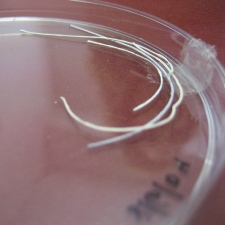Professor Mittal Zilberman from the Department of Biomedical Engineering has developed an innovative wound dressing based on fibers she created - fibers loaded with drugs such as antibiotics to speed up the healing process, capable of breaking down by themselves and dissolving at the end of their activity

Despite advances in treatment methods and the best efforts of nurses and doctors, approximately seventy percent of the injured who suffer from severe burns die as a result of inflammation resulting from the burns. However, an innovative and revolutionary wound dressing developed at Tel Aviv University could significantly reduce these numbers.
Professor Mittal Zilberman from the Department of Biomedical Engineering developed an innovative wound dressing based on fibers she created - fibers loaded with drugs such as antibiotics to speed up the healing process, capable of breaking down by themselves and dissolving at the end of their activity.
The study, published in the scientific journal Journal of Biomedical Materials Research — Applied Biomaterials, showed how this bandage, after only two days, is able to destroy the bacteria that cause the inflammation.
The new bandage protects the wound until it is no longer needed, then it simply dissolves. "We developed the first wound dressing that is capable of both releasing antibiotic drugs from it and decomposing biologically in a controlled manner," says the researcher. "The bandage overcomes existing mechanical and physical limitations in wound dressing methods and provides caregivers with an innovative and more effective means of treating burns and pressure sores."
While the idea itself is simple, the method is not so at all. The skin, the researcher explains, is used for a relatively large number of different purposes. "A wound dressing must maintain a certain level of moisture while functioning as a protection," explains the researcher. "Similar to the skin, the bandages must also allow fluids to be secreted out of the inflamed tissue at a certain rate. This rate must not be too slow or too fast - if it is too fast, the wound will dry out completely and will not heal properly; If it is too slow, there is a real risk of increased infection."
Professor Silberman's innovative bandage, which still lacks an official name, was designed to mimic the skin and its ability to protect the body. It combines positive physical and mechanical properties together with what medical researchers call "a desired form of release of antibiotic substances".
Unlike orally administered antibiotics, topically administered agents are able to locate and eliminate harmful bacteria before they enter the body and cause further inflammation, sepsis, or even death. "People who suffer from extensive burns, usually do not get rid of the condition itself - the fatal culprit is secondary infections caused by bacteria that invade the body through these vulnerable burn areas," explains the researcher.
The modern bandage prevents the development of bacteria and is biodegradable, a fact that helps doctors avoid cleaning and dressing the wounds frequently and thus allows the body to perform the task itself. "When the treatment is local to the wound, a doctor is able to provide a high but local dose of antibiotics, thereby avoiding issues of toxicity that arise when the same amount of the drug passes through the body," explains the researcher.
Professor Silberman is now beginning the early stages of clinical trials on models of IBD. So far, its wound dressing has successfully passed in vitro physical and mechanical tests and laboratory bacterial inhibition tests. In addition, it sought a strategic partner for joint development of the research and commercialization of the bandage.

One response
I liked.